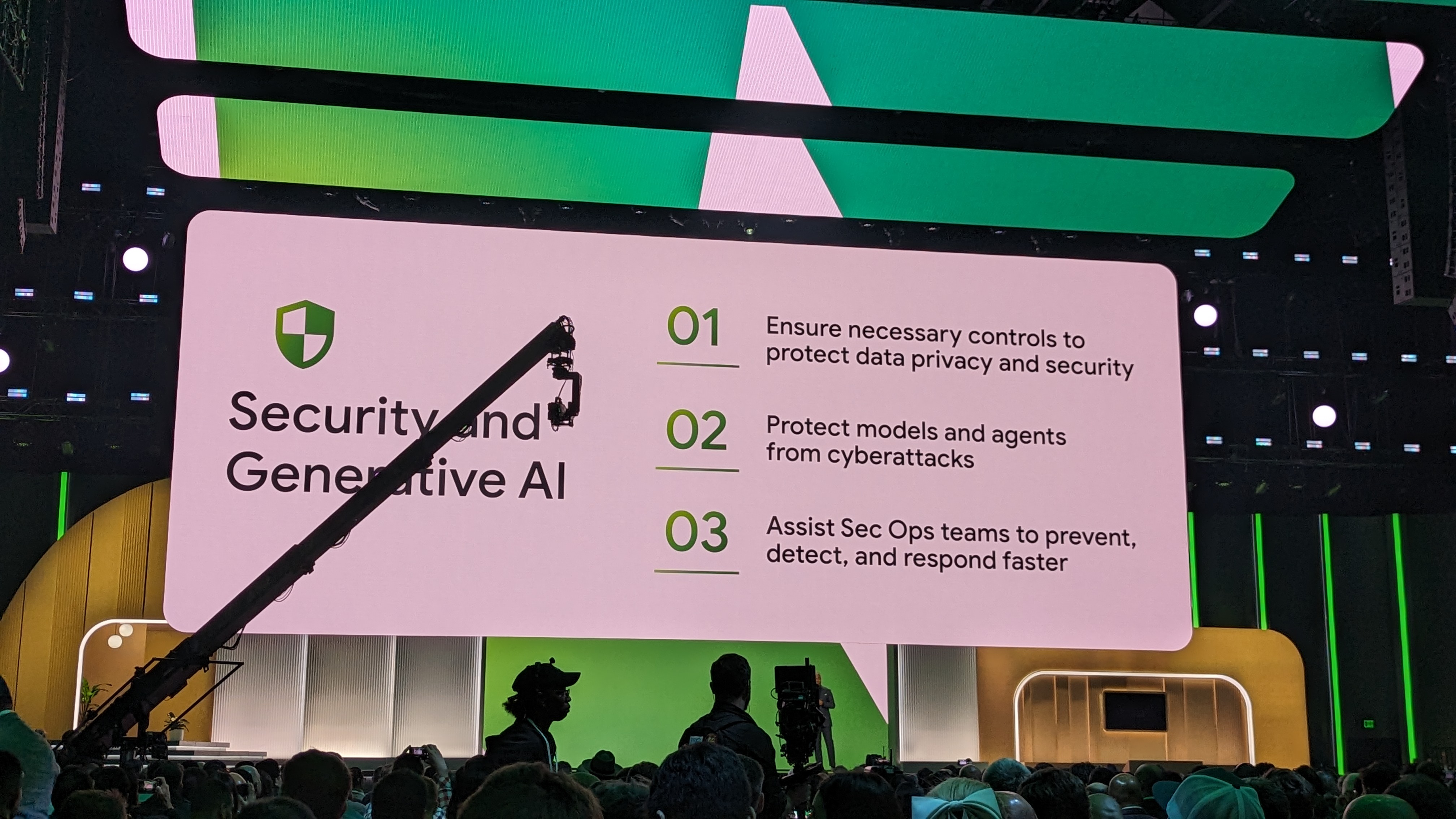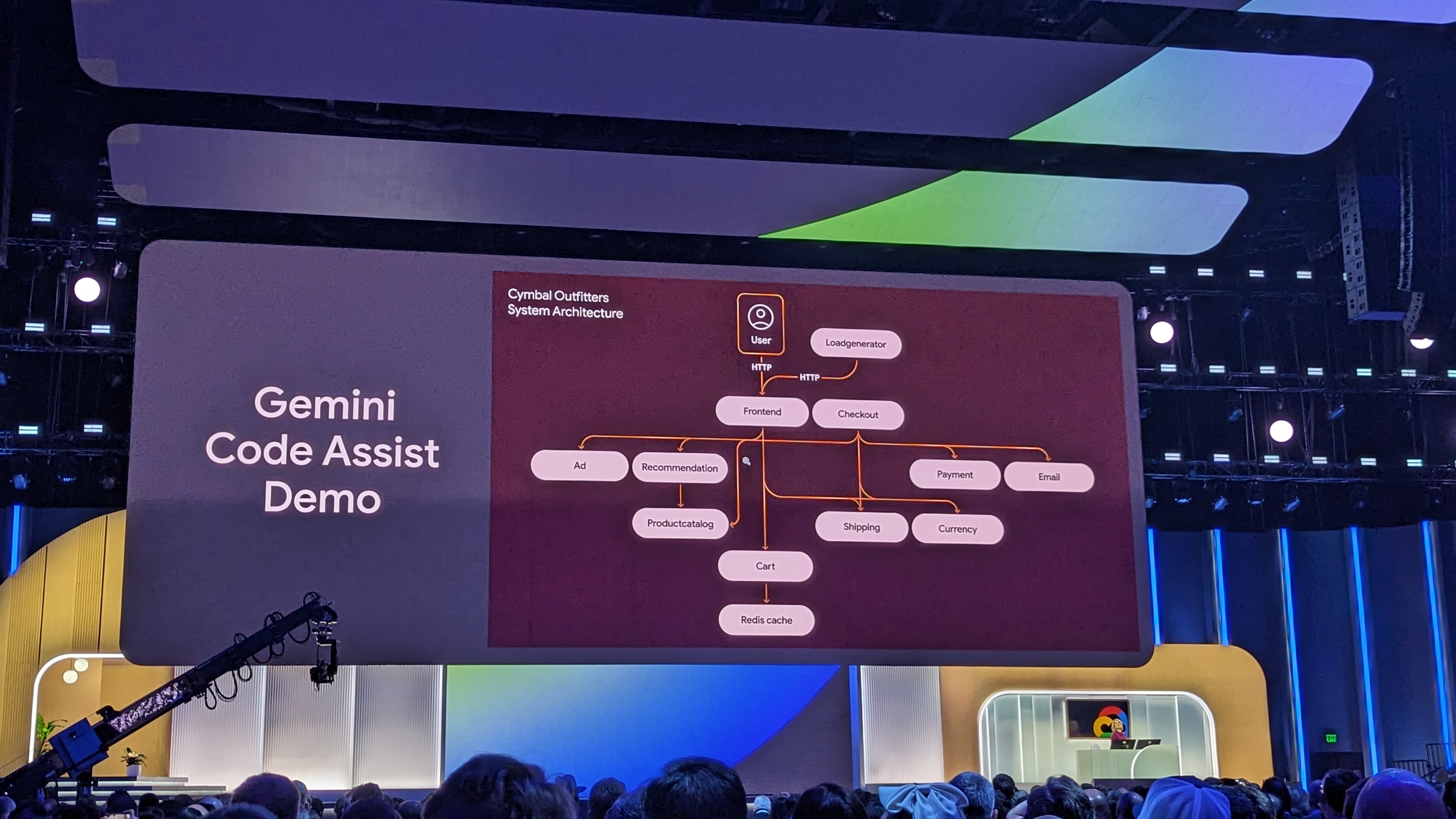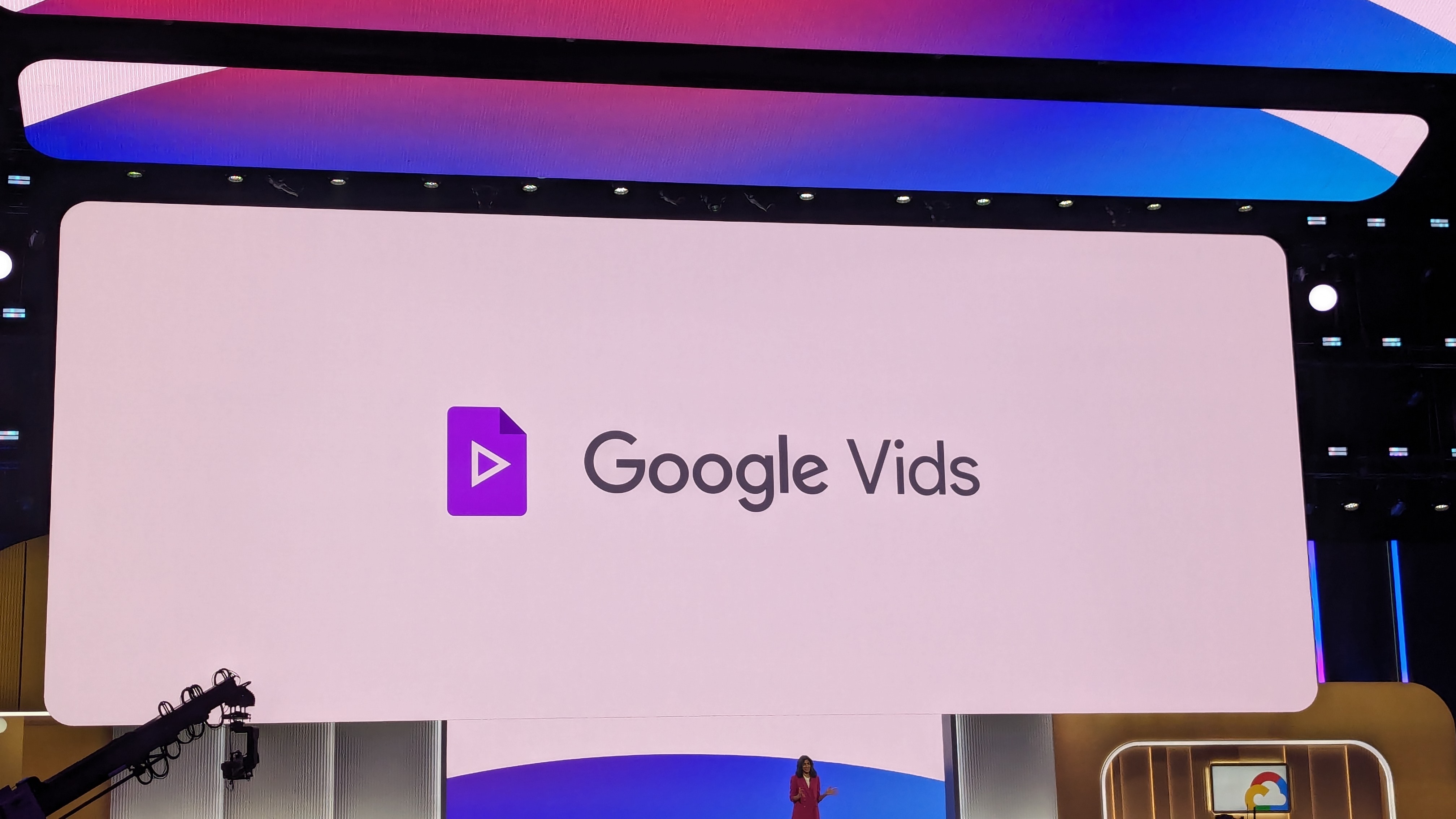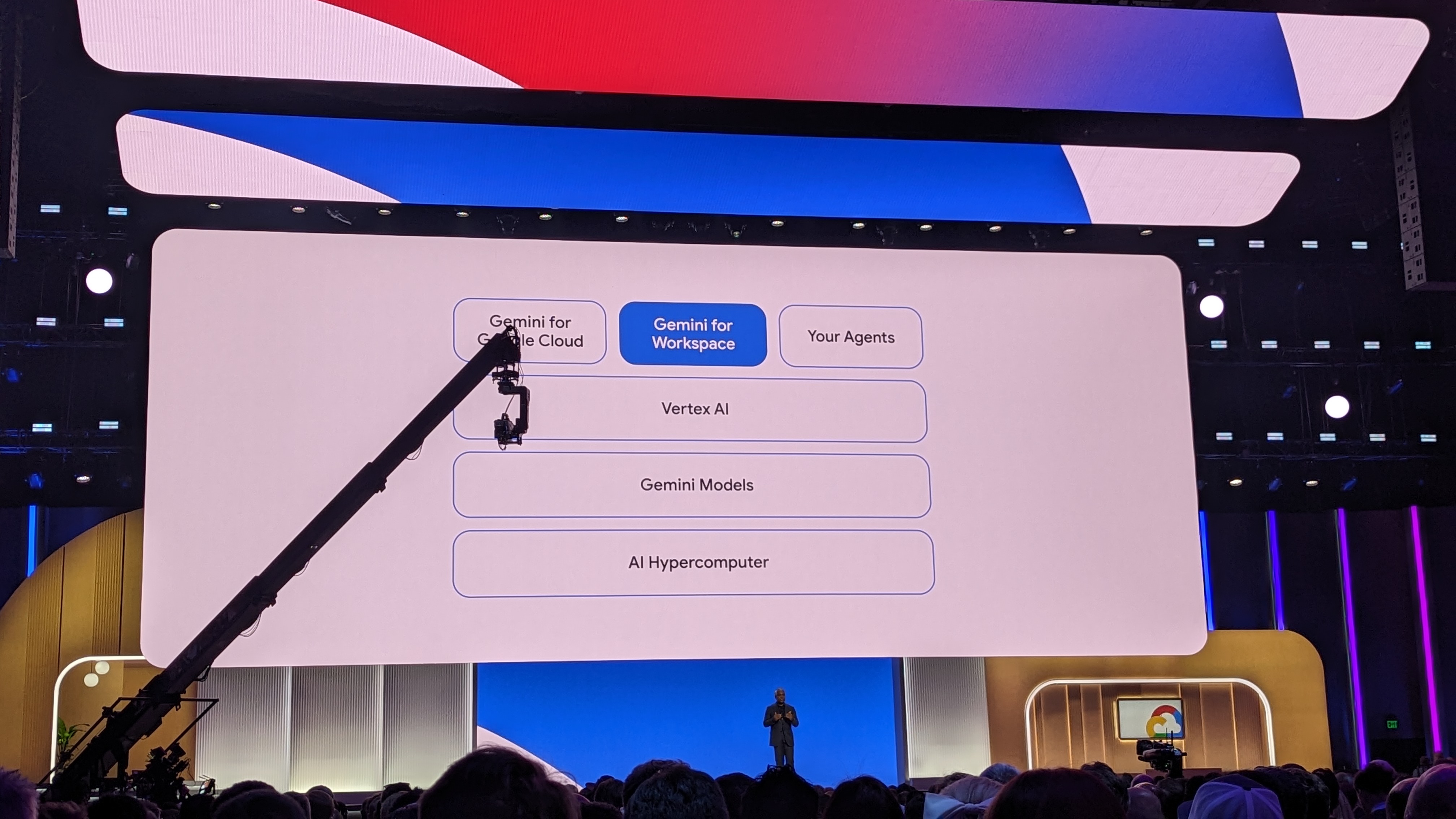Refresh
What’s happened so far at Google Cloud Next?
Day-one at Google Cloud Next was a very busy affair. In the opening keynote, CEO Thomas Kurian took us through all the developments at the cloud giant over the last year.
It’s hard to believe it’s only been eight months since the last event when you consider the rapid pace of change both at the company and in the cloud computing and AI space.
Naturally, we saw a lot of product announcements, with a sharp focus on Google’s exciting Gemini large language model range. Gemini appears very much woven into the fabric of Google Cloud offerings now, and the firm is keen to get customers innovating with its array of features.
We also had big updates for Google Workspace, with more Gemini-powered tools being rolled out for the productivity software suite.
It’s going to be another hectic day here at the conference, so be sure to keep up to date with all the announcements here in our rolling live blog.
“Together, we’re creating a new era of generative AI agents built on a truly open platform for AI. And we’re reinventing infrastructure to support it,” Kurian says, noting that all of today’s announcements feed into one another to form an end-to-end platform for AI.
And with that, today’s keynote is officially over. It’s been a whirlwind of announcements, with barely any pausing for breath over the past 90 minutes. Stay tuned for more from the conference via ITPro throughout the week.

Security in the age of AI
Kurian is back on stage to emphasize the importance of security when it comes to AI. He explains that Google Cloud is committed to ensuring AI risk is not only mitigated, but also using AI to actively fight back against threats.
Combining Google’s threat intelligence with Mandiant data, Kurian says Gemini in Threat Intelligence will surface threats using natural language prompts. This is another area where Gemini 1.5 Pro’s long context window comes in handy, he adds, as the model is capablke of analyzing large amounts of potentially malicious code.To summarize, Kurian outlines three areas Google Cloud is intensely-focused on when it comes to security and AI:
“First, to ensure our delivery platform protects the privacy and security with data we provide sovereignty and compliance controls, including data location, encryption, and access controls.
“Second, we continue to enhance our AI platform to protect your models and agents from cyber attacks that malicious prompts can bring.
“Third, we’re applying generative AI to create security agents that assist security operations teams by radically increasing the speed of investigations.
Palo Alto is aligned with Google Cloud on these goals, Kurian says. To expand on this we’re now being shown a video of Nikesh Arora, CEO at Palo Alto Networks.
“Very excited about all the capabilities that Gemini brings to the fore,” he says. “This large language model has allowed us to do things a little faster, get more precise, we’re hitting numbers north of 90% in terms of accuracy. Effectively, what we’re seeing in terms of early trials is it makes our usability better, our explainability better.”

Gemini in Security Command Center is another area in which AI is being used to respond to threats. The service lets businesses evaluate their security posture and summarize attack patterns more quickly.
Google’s answer to GitHub Copilot is here
Gemini Code Assist is a major announcement at today’s conference. It’s Google Cloud’s new built-in AI pair programmer, capable of generating vast amounts of detailed code and producing tailored outputs based on a company’s own codebase.
We’re now hearing from Fiona Tan, CTO at Wayfair, which has already used Gemini Code Assist to improve developer productivity.
“We chose Gemini Code Assist after running a number of pilots and evaluations,” Tan says. “The results against control showed significant improvements across the spectrum.”
At Wayfair, developers were able to set environments 55% faster with Gemini Code Assist, with 60% of developers stating they were able to focus on more satisfying work as a result.
Gemini Code Assist supports code bases anywhere, we’re told – not just GitHub. With Gemini 1.5 Pro in code assist, this will allow entire codebases to be transformed at once, through Gemini 1.5 Pro’s one million token context window.
Another key announcement made today is Gemini Cloud Assist, a tool that helps teams design and manage their application lifecycle. The tool can answer questions about user cloud issues or even suggest architectural configurations based on a natural-language description of a business’ needs.

In a demo, we’re shown Gemini Code Assist being used to complete a task in HTML that we’re told would normally take days in just minutes. In the scenario, a fictional company’s marketing team has asked a developer to move a custom recommendation service, normally shown only to customers after they’ve made a purchase, to the homepage for all to view.
This will be based on a Figma mockup produced by the company’s design team.
“For the developers out there, you know that this means we’re going to need to add padding on the homepage, modify views, and make sure that the configs have changed for our microservices,” says Paige Bailey, product manager for generative AI at Google Cloud.
“Typically it would take me a week or two just to become familiarized with our company’s codebase which has over 100,000 lines of code across 11 services.”
WIth Gemini Code Assist, Paige shows us that she can simply ask Gemini to produce a “for you recommendation section on the homepage” and provide images of the approved design. In response, Gemini Code Assist finds the function used for recommendation, identifies the calls needed, and highlights which files need changes using codebase context. These changes can then be accepted by a developer, for ease of use while also ensuring a human is involved.
Using behind-the-scenes analysis of the user’s codebase in GitLab, Gemini can suggest functions while keeping the developer in the loop throughout the whole process. This is something that not all AI models could handle, as many have context windows that couldn’t handle an entire codebase at once.
To dig into this in more detail, we’ve got another live demo (we were promised “real live”, after all). Using a custom data agent within Looker, analysts can interrogate data using natural language.
As an example, we’re shown an agent using prompts such as “Show me projected supply levels compared to demand” and given a graph in return. Following on from this, the agent can be asked to find products that look similar to an image uploaded by the user (in this case a stylish Google Cloud shoe), with summaries of the price range and delivery schedule for the top three results.
Users can ask the agent to draw correlations between supply and sales, or other data points based on their enterprise data. To round this off, the analyst can ask for the information to be complied and shared with the relevant team.
Moving away from creative applications, Vertex AI Agents can also be used to comb through enterprise data, with ‘data agents’ able to use natural language queries for powerful data analytics and search functionality.
In a video clip, we’re told that Walmart is already using Google Cloud’s Vertex AI data agents for data analysis purposes, while News Corp is using data to search through 2.5 million news articles from across 30,000 sources. Vodafone also uses data agents to empower its 800 operators to quickly search around 10,000 contracts.
A major announcement from today is that Vertex AI can be seamlessly integrated with BigQuery for data searches. We’re told that by combining Vertex AI and BigQuery, businesses can expect up to four times faster performance.
Sifting through enterprise data is laborious, but Vertex can help

Generative AI has applications in the creative space and to capitalize on this fully, Google Cloud has today launched a brand new app in Workspace: Google Vids.
“Google Vids is an AI-powered video creation app for work,” Pappu says, explaining that it can be used to easily put together event montage videos and slideshows. It will also produce scripts based on the videos and can be tweaked using videos in Drive and files from across a user’s business.
Based on an outline provided by users, Vids can generate edited videos scored with royalty-free music and containing Google-licensed stock footage.
Rooted within Workspace, Vids comes with the same collaboration capabilities as Docs, Sheets, and other Google apps.
Some customers have already had access to Vids, with Pappu promising more details in tomorrow’s keynote. Other creative applications for generative AI announced today include ‘text-to-live-image’ within Imagen 2, which turns text into GIF-like images and Digital Watermarking so that AI-generated images can be easily identified.
Beyond the off-the-shelf version of Gemini, Google Cloud is emphasizing the power of training your own employee agents within Vertex AI. Companies can train and ground their agents in their enterprise data, with new multimodal capabilities allowing video and audio to be fed in directly.
Pappu adds that Gemini is also capable of translation inherently, which could be ideal for companies looking to draw in context from across their global offices.
In yet another demo, we’re show an employee using a custom agent to compare 2025 benefits plans. Using its large context window, Gemini can draw in data from across multiple company PDFs and present it in a digestible format so the employee can make an informed decision on their healthcare plan.
Via API, the agent can even connect to Google Maps and the employee’s orthodontic plan to suggest nearby clinics that fall under their plan, with each option summarized with annotations. All of this helps the employee to quickly research their options – at the end of the process, the agent can even suggest a time for a call with the clinic that doesn’t clash with the employee’s schedule.
With its in-built language support, Gemini can also handle this across mutliple languages. Google Cloud says that this will help empower employees wherever they work – in the demo, the employee can be shown the medical plan comparison in English and Japanese simply by asking.
That’s the customer side of the experience, but what about developer and employee productivity? Uber is using Gemini for Google Workspace and we’re now being told more by Dara Khosrowshahi, CEO at Uber, via video insert.
Uber is already using Google Cloud to summarize user communications and provide context on previous conversations.
To expand on this, Aparna Pappu, GM and VP of Workspace at Google Cloud has taken to the stage.
Shots fired at rivals
Gemini for Workspace is capable of securely processing data from across an organization’s ecosystem to provide context and answer questions to improve employee productivity.
We’re starting with some shots fired at Webex, Zoom, and Microsoft Teams, with Pappu noting that Meet has been shown to outperform these platforms on audio and video quality. But to press this lead further, Google Cloud is bringing its Gemini assistant across all its workplace apps.
AI meetings and messaging add-on brings AI translation and note-taking for $10 per user, per month. To explain more, we’re being treated to another live demo in which a user can unpack how Gemini can summarize and explain files within Docs.
Using Gemini’s side panel, a user can enter the prompt “Does this offer comply with the following” and attach a Google Doc of their company’s supplier compliance rulebook to see if an 80-page proposal has any compliance issues. In seconds, the model is able to identify a security certificate issue within the document.
“The opportunity of customer agents is tremendous,” Kurian says, which is why Google Cloud has put a lot of work into making the process of using the new Vertex AI Agent Builder as simple as possible.
Powered by Gemini Pro, agents can hold free-flowing conversations, shape conversations, and return information that is grounded in enterprise data.
Agents can be integrated with data from BigQuery or SaaS applications for more context and to help them generate as detailed results as possible. To explain more, we’re being shown a demo by Amanda Lewis, developer relations engineer at Google Cloud.
An agent can use Gemini’s multimodal reasoning to identify and find a product based on a descriptive prompt of a video. The prompt “Find me a checkered shirt like the keyboard player is wearing. I’d like to see prices, where to buy it, and how soon I can be wearing it” returns the product quickly and with all the relevant information.
This can then be followed up with a phone conversation with the agent, in which speech is processed to answer questions about the product, action the purchase, and give tips on similar products and active promotions.

Google Cloud is doubling down on Vertex AI
Kurian moves smoothly onto Vertex AI, which Kurian says is the only solution that offers a “single platform for model tuning and infrastructure”.
More than 130 models are available through Vertex AI, including Google’s own Gemini family of models. Kurian stresses that with Gemini 1.5 Pro, Vertex just became more seamless. Putting its one million token context window in perspective, he says it can handle the equivalent of:
• One hour of video
• 11 hours audio.
• 13,000 lines code.
• 700,000 words.
Kurian adds that third-party and open models are an equally important part of Google Cloud’s AI offering. He notes that today, Google Cloud has announced Anthropic’s Claude 3 will come to Vertex AI, alongside the lightweight open coding model Code Gemma.
‘Supervised Tuning for Gemini Models’ will help businesses augment models in a simple way. Models can be linked to existing data via extensions in Vertex and data can also be used for retrieval-augmented generation (RAG).
To address hallucinations, Kurian emphasizes that AI models can now be grounded in Google Search, which he says “significantly” reduces hallucinations and improves responsiveness. This could make AI agents though Google Cloud more of a feasible option for public bodies and protected industries that need accurate information grounded in truth.
Google Axion is here
Thomas Kurian has emerged from a spinning wall to unveil Google Axion, Google’s first custom, Arm-based CPU for the data center. It is capable of providing 60% better energy efficiency than other x86 instances and 50% performance improvements over competing chips.

“That’s why we’ve already started deploying Axion on our base instances, including BigQuery, Google Earth Engine, and YouTube Ads Cloud,” Kurian says.
Infrastructure is crucial in the age of AI
Kurian notes that infrastructure is all-important to support AI development in the cloud and introduces Amin Vahdat, VP Systems and Infrastructure at Google Cloud to unpack today’s slew of infrastructure announcements.
Vahdat runs through a string of new announcements across Google’s AI Hypercomputer, including the general availability of its new v5p TPU AI accelerator and the upcoming rollout of Nvidia’s new Blackwell chip family to Google Cloud.
The firm has also targeted load-time improvements through Hyperdisk ML, a block storage solution that can offer up to 11.9x improvements over comparable alternatives.
To read more about today’s AI Hypercomputer and infrastructure news, check out our in-depth coverage.
Passing the baton back to Kurian, we’re being given an overview of some of today’s news.
“Our biggest announcements today are focused on generative AI,” Kurian says, explaining that Google Cloud is focused on AI ‘agents’ that can be used to process multimodal information to automate complex tasks such as personal shopping or making employee handoffs for nurses more automated.
Teasing these leaps is one thing, but grounding them in tangible improvements to business processes is key.
Here (via video) to explain more is David Solomon, chairman and CEO at Goldman Sachs.
“At Goldman Sachs specifically, our work with generative AI has been focused on three key pillars: enabling business growth, enhancing client experience, and improving developer productivity
Solomon says the evidence already shows that generative AI can be used to improve developer efficiency by up to 40%. The company is also exploring ways to use AI to summarize public filings and gather earnings information.
To go into more detail, Kurian welcomes Sundar Pichai in a pre-recorded video to go into more detail on some of the biggest advances Google Cloud has made.
Nearly 90% of AI unicorns are Google Cloud customers, Pichai tells the audience. Focusing in on Gemini, he stresses the vast advances that have been made with Google’s in-house model in the past year alone – Gemini 1.5 Pro, now being made generally available, can run one million tokens of information consistently and can process audio, video, code, text, and images through its multimodal form.
These could be used, Pichai says, by an insurance company to take in video and images of an incident and automate the claims process.
We’re told to expect testimonies from representatives at companies like Uber, Goldman Sachs, and Palo Alto to explore concrete ways in which Google AI is already changing business processes.
“AI is a today problem”
We’re off, starting with a stylized countdown to the official start of the conference and quickly moving into a video montage of some of Google Cloud’s recent breakthroughs in AI
At Google, we’re told, “AI is a today problem” with the montage taking in the various business use cases for Google AI. “It can translate from code to code and is one step closer to speaking a thousand languages.” We’re also told it has transformational applications for analytics and security.
Here to tell us more is Thomas Kurian, CEO at Google Cloud. “It’s been less than eight months since Next 2023,” he begins, adding that in this time Google Cloud has introduced over 1,000 product advances and moved forward with infrastructure such as unveiled six new subsea cables.
“Five minutes until true live,” we’ve just been told. Is it too much to hope that this will mean a properly live demo of Gemini? Live demos are often spurned at tech conferences as they present a risk, so if we get treated to this it would be a real vote of confidence by Google Cloud in its products.
Right now we’re being treated to ‘Eventually’ by Tame Impala. Can’t help but feel that the lyrics “I know that we’ll be happier… eventually” align with this need to spell out the value of generative AI in more detail. Businesses will be looking at Google Cloud Next to lay out a long-term idea of what sets Google Cloud apart from its hyperscaler competitors and how soon they can expect returns on their investment.
Some key things to look out for at today’s keynote will be a demonstration of the new Gemini capabilities for Workspace, as well as more detail on how AI innovations can help enterprises in concrete terms.
We’re well into the second ‘year of generative AI’ at this point, so Google Cloud should be looking to explain the tangible benefits of each announcement. That’ll mean live demos, stats, and a clear roadmap for AI updates – we’ll be breaking all that down for you as and when it comes.
Just 25 minutes until the keynote kicks off and the Michelob Ultra Arena is buzzing. As expected, the marketing material shown on screen is leaning heavily on AI this year with the slogan ‘the new way to cloud’ referring to the end-to-end innovations Google Cloud is unpacking in today’s session.

The sun has risen on Las Vegas and soon it will be time to enter the Michelob Ultra Arena at Mandalay Bay to hear the latest announcements and insights at the opening keynote.
Already this morning we’ve covered Google’s extensive additions to its AI Hypercomputer and cloud AI infrastructure, with Nvidia Blackwell chips coming to the platform and new in-house accelerators helping customers inference and fine-tine even the most demanding AI models.
Google Cloud has also unveiled a slew of new AI features for Workspace aimed at improving productivity, powered by Google’s Gemini model family. New features across Gmail, Docs, Meet, and Chat include ‘take notes for me’ and ‘translate for me’, powered by Google’s in-house LLM.
Stay tuned for more of the latest, with the keynote set to kick off at 9 am PT.

Gemini won’t be the only talking point at this year’s conference, however. We can expect to see a flurry of updates on Google Workspace, particularly with regard to AI integration and new features aimed at further supporting user productivity.
In August last year, Google loaded Workspace with a range of Duet AI features, but with Gemini the new kid on the block, we’re excited to see what else the company has in store for the workplace productivity software.
While we’re waiting for the keynote sessions to begin today, you can read more about our predictions from Google Cloud Next and what could be in store for delegates.
• Three reasons why you need to pay attention to Google Cloud Next 2024









